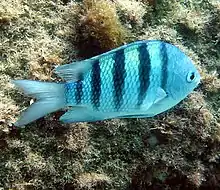Sergeant major (fish)
The sergeant major or píntano (Abudefduf saxatilis) is a species of damselfish. It grows to a maximum length of about 22.9 centimetres (9.0 in).[2]
| Sergeant major | |
|---|---|
 | |
| Sergeant fish near Paraty, Brazil | |
| Scientific classification | |
| Kingdom: | Animalia |
| Phylum: | Chordata |
| Class: | Actinopterygii |
| Family: | Pomacentridae |
| Genus: | Abudefduf |
| Species: | A. saxatilis |
| Binomial name | |
| Abudefduf saxatilis | |
| Synonyms | |
| |
Distribution and habitat
Abudefduf saxatilis is found in the Atlantic Ocean.[2] Populations in the western part of the Atlantic Ocean are found from the north eastern coast of the United States south to the Gulf of Mexico, the Bahamas, islands around the Caribbean Sea, the eastern coast of Central and South America all the way to Uruguay.[2] In the eastern Atlantic Ocean, they are found from Portugal, Azores, the Canary Islands, Cape Verde, and western Africa.[2] Juveniles are common in tide pools while adults are found over coral reefs.[2] Sergeant majors are found at depths of 0 to 40 metres (0 to 131 ft).[2] It has been recorded in the Mediterranean Sea in both eastern and western areas, it was originally thought to be the Red Sea species Abudefduf vaigiensis which was thought to be a Lessepsian migrant from the Red Sea through the Suez Canal but it has been found that the majority, if not all, of the specimens from the Mediterraean are of A. saxatilis.[3]
Description
Adults can grow up to 22.9 centimetres (9.0 in) at maximum length.[2] Normally, they would grow up to 15 centimetres (5.9 in).[2] The largest recorded specimen weighed had a weight of up to 200 grams (7.1 oz).[2] Abudefduf saxatilis has 13 dorsal spines, 12 to 13 dorsal soft rays, 2 anal spines, and 10 to 12 anal soft rays.[2] This fish is white with a yellow top. It has 5 vertical stripes which are black. A faint sixth stripe might be present on the caudal peduncle.[2] Adult males have a more bluish coloration and its stripes are less visible.[2] There is a dark spot around its pectoral fin.
Ecology

Diet
This fish feed upon the larvae of invertebrates, zooplankton, smaller fish, crustaceans, and various species of algae.[2] It is also known to feed on the waste and vomit of spinner dolphins.[2]
Behavior
Individuals of this species form aggregations of about several hundreds of individuals.[2] Sometimes, they get cleaned of parasites by fish species such as gobies in the genus Gobiosoma, Bodianus rufus, Elacatinus figaro, and Thalassoma noronhanum.[2] Sergeant majors also clean green sea turtles with Acanthurus chirurgus and Acanthurus coeruleus.[2]
Predators
Predators of this fish include Plectropomus leopardus, Thalassoma bifasciatum, Cephalopholis cruentata, Epinephelus striatus, Mycteroperca venenosa, and Rachycentron canadum.[2]
In the aquarium
They are found in the aquarium trade but are regarded as difficult to breed.[4]
Reproduction
The sergeant majors is an oviparous species in which the males create nests where the females to lay their egg masses on rocks, reef outcrops, shipwrecks, and pilings.[5] The males actively chase the females in courtship before the female releases approximately 200,000 ref, ovoid eggs which are attached to the substrate by a filament, the eggs turn greenish after a few days and are guarded by the male. As he guards the eggs the male becomes bluish in colour, guarding them for about a week.[6]
Etymology
Sergeant majors earn their name from its brightly striped sides, known as bars, which are reminiscent of the insignia of a military sergeant major.[6]
References
- Rocha, L.A. & Myers, R. (2015). "Abudefduf saxatilis". The IUCN Red List of Threatened Species. 2015: e.T188581A1896808. doi:10.2305/IUCN.UK.2015-4.RLTS.T188581A1896808.en.
- Froese, Rainer and Pauly, Daniel, eds. (2014). "Abudefduf saxatilis" in FishBase. December 2014 version.
- Rami Tsadok; Maxim Rubin-Blum; Eli Shemesh & Dan Tchernov (2015). "On the occurrence and identification of Abudefduf saxatilis (Linnaeus, 1758) in the easternmost Mediterranean Sea" (PDF). Aquatic Invasions. 10 (1): 101–105. doi:10.3391/ai.2015.10.1.10.
- Matthew L. Wittenrich. "Raising Sergeant Majors (Full Article)". Tropical Fish Hobbyist Magazine. Retrieved 4 October 2018.
- Melany P. Puglisi (1 August 2008). "Abudefduf saxatilis". Indian River Lagoon Species Inventory. Smithsonian Maine Station at Fort Pierce. Retrieved 4 October 2018.
- Cathleen Bester. "Sergeant Major". Discover Fishes. Florida Museum. Retrieved 4 October 2018.
External links
- Photos of Sergeant major on Sealife Collection
| Wikimedia Commons has media related to Sergeant major. |
| Wikispecies has information related to Abudefduf saxatilis. |
